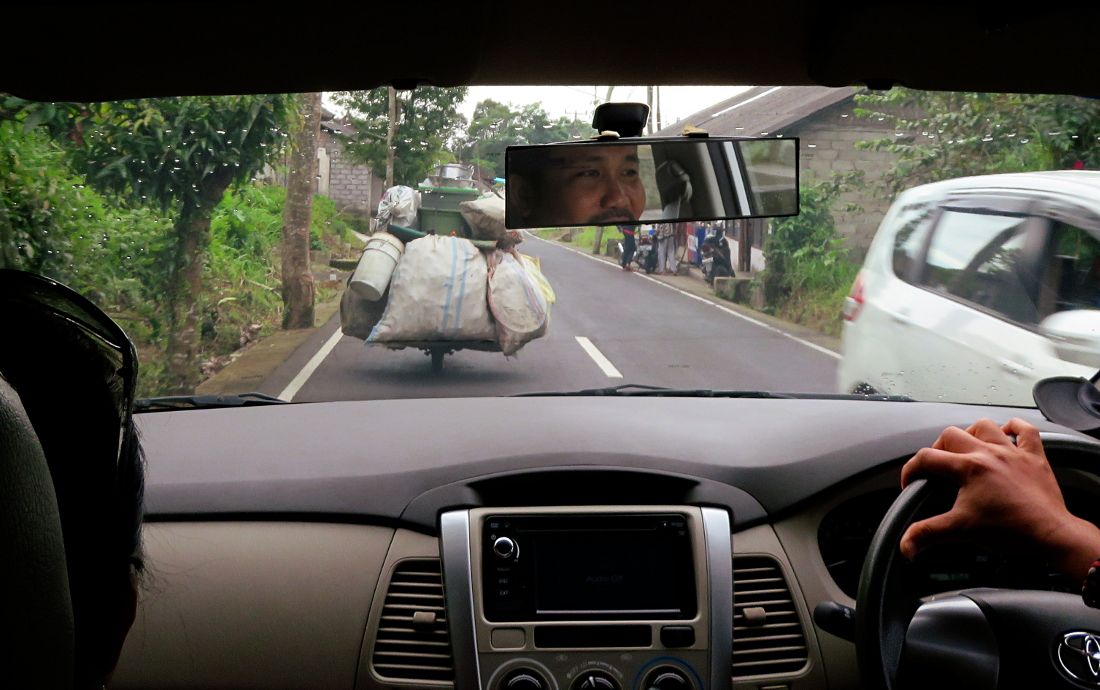Note: the Idiots are at home in Arizona working through a couple of thousand photos and lots of stories. This episode describes events on January 29, 2017 in Ubud, Bali.
--------------------------------------------------------------------
The Idiots are pretty independent travelers, but they knew that Bali is notorious for narrow roads and crazy traffic. Plus, they knew that they often have no idea how to interpret what they are seeing. There is no substitute for a good guide!
Their criteria were simple – a person with charm, a good heart, experience guiding and a good command of English. A little internet research kept turning up the same name - Sanny Santika Mandala / http://www.sannybalitours.com/. They reserved two days with Sanny. They were clear with him that they didn’t have enough time to do serious research and develop a list of “Greatest Hits.” They trusted Sanny to consider their interests and design good itineraries.
Sanny turned out to be an absolute gem. He arrived at their hotel and asked a few questions to get a sense of what kind of travelers the Idiots are. The salient answers: slow… easy… no long hikes… culture… natural beauty… not much interest in shopping… waterfalls… volcanoes and mountains… ocean… no amusement parks.
Sanny thought a bit and one could see the times and distances and routes rearranging in his head. Final result: waterfall that can be viewed from a distance; rice fields and typical Balinese living; Pura Tirta Empul – The Spring Temple; Mt. Batur volcano and lake; Tagalang Historic Rice Terraces… home in time for cocktails. And off they went!
Sanny took his lead from the Idiots’ questions. The conversations focused on what life is like for the typical Balinese person. The sights were put into cultural, historical, and geological perspective. It was at least as rewarding to chat with Sanny as to actually visit the varied destinations.
Readers are invited to take a digital ride-along. Lots of photos… so much to experience!
----------------------------------------------------
The Idiots said “waterfall” – Sanny showed them a waterfall! There are lots of waterfalls on Bali. Indonesia is located on “The Ring of Fire” - the margins of the Pacific plate where tectonics has produced the most seismically active areas in the world. Volcanoes produce rugged mountains – and waterfalls.
Hundreds make the trek to the top and bottom of this waterfall every day. The Idiots were satisfied to enjoy it from an overlook. It was fun to watch a photographer’s assistant getting his directions by radio under the roar of the falls, posing and adjusting a wedding couple in a very dramatic setting, and then ducking down behind the couple as the photos were taken.
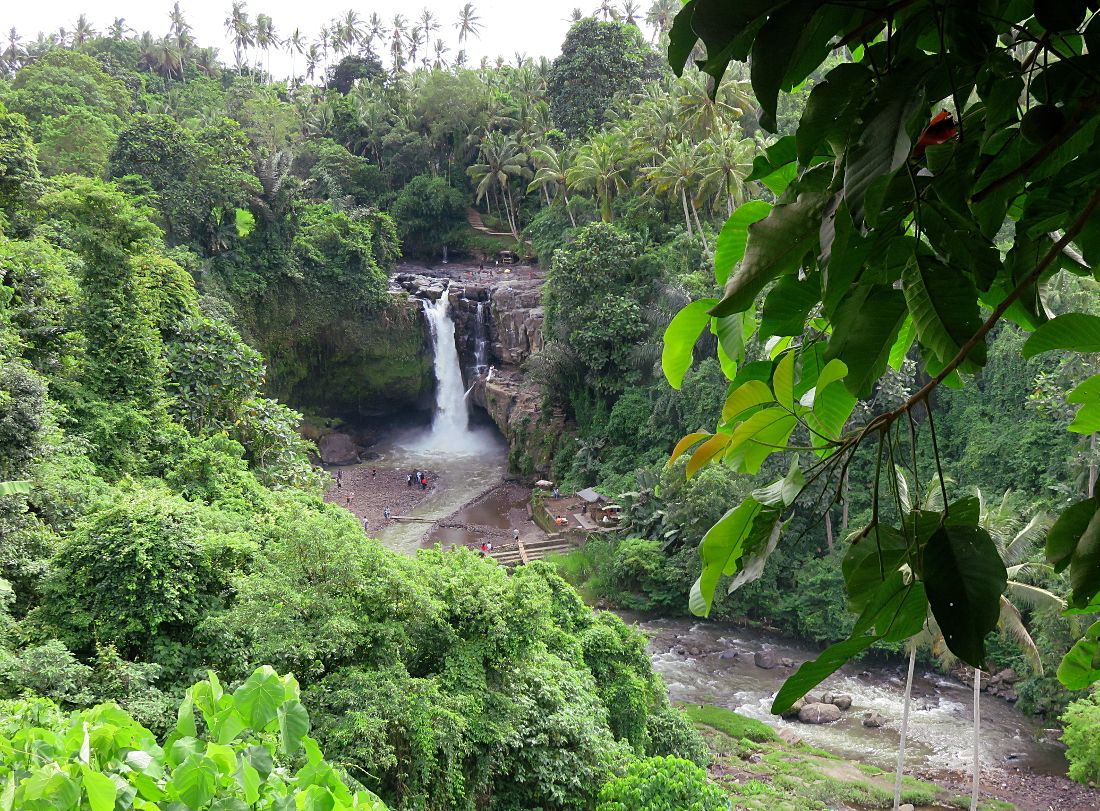
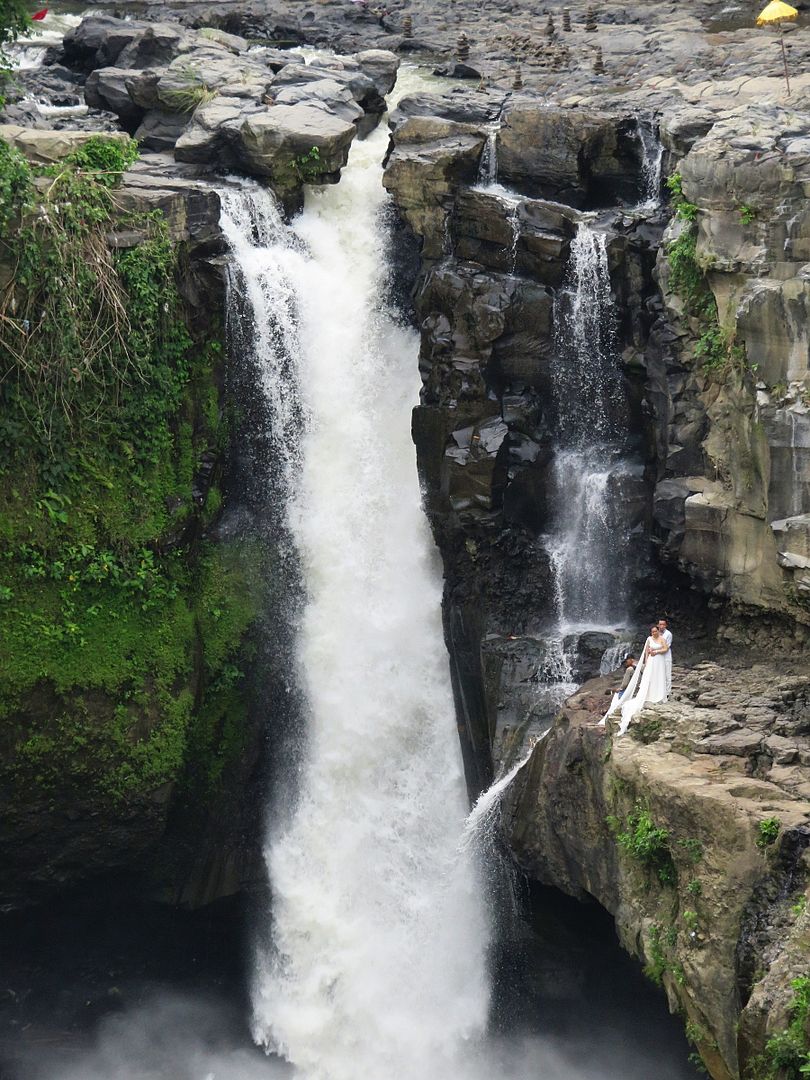

The Idiots didn’t know the difference between cows and oxen until they Googled it. Cows are cattle that produce dairy and meat – oxen are cattle used to do farm work like plowing and pulling carts. Throughout Southeast Asia it is still common to see farmers plowing rice fields with Brahma oxen, just as they’ve done for centuries. Some have made the transition to these small walk-behind tractors.

Bali has over 10,000 Hindu temples and shrines – amazingly, about one for every 375 Hindus on the island. All of them are interesting and a few are world-famous tourist sites. Some of the temples are largely maintained as historical and cultural resources while others are still integral to the spiritual lives of the Balinese.
Pura Tirtha Empul doesn’t usually show up on Bali’s “Top 5 Temples” lists, but it is a very special place. “The Spring Temple” was founded in 926 CE and is centered on a sacred spring that has produced a steady flow of holy water for over a thousand years. Every year hundreds of thousands of Balinese Hindus make the pilgrimage to cleanse themselves in the water from the holy spring and to ask for deliverance from evil and illness and for blessings in their lives.
Since this is a real, active temple, visitors are asked to show respect for the religious traditions and mores and follow some basic rules. Anyone can participate in the cleansing and the blessings, but their dress and behavior must be appropriate. Men and women are expected to wear saris. Shoulders must be covered. Women are asked to avoid the temple during their periods. After bathing, people must change into dry clothing before entering the inner temple for worship.
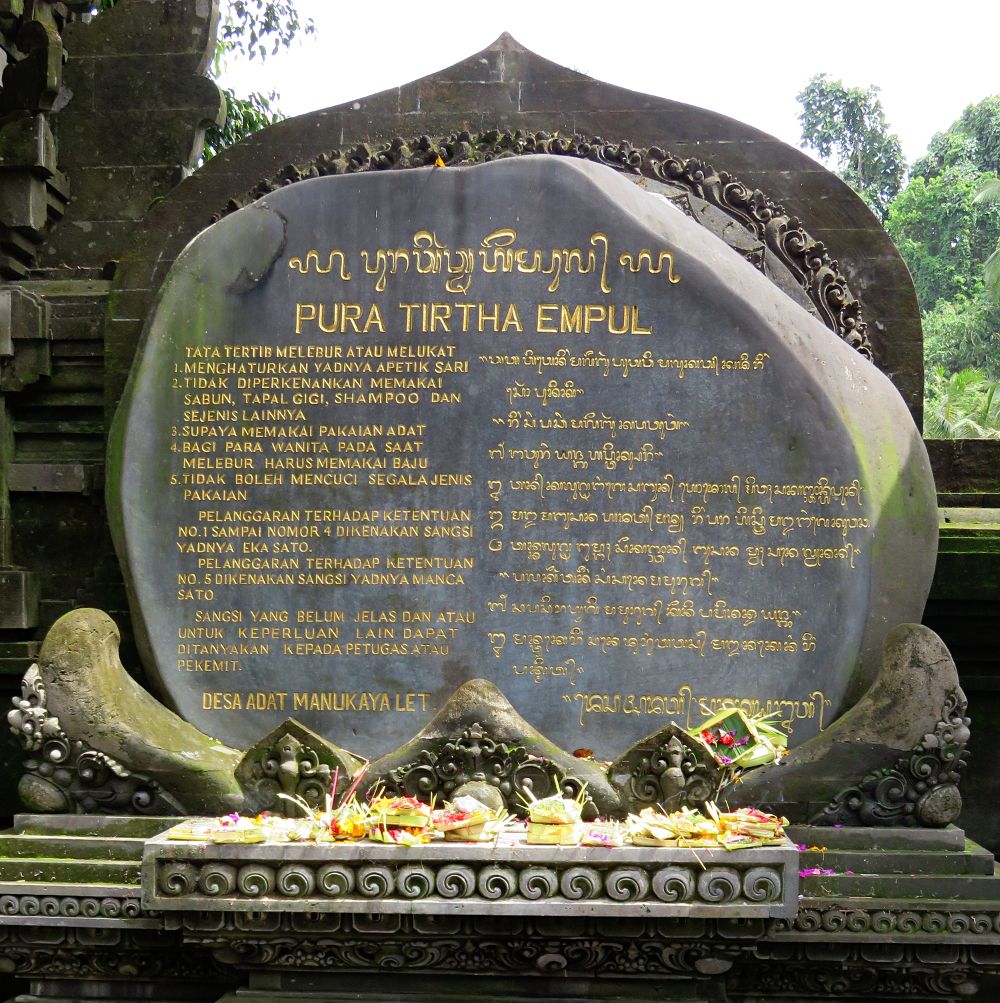
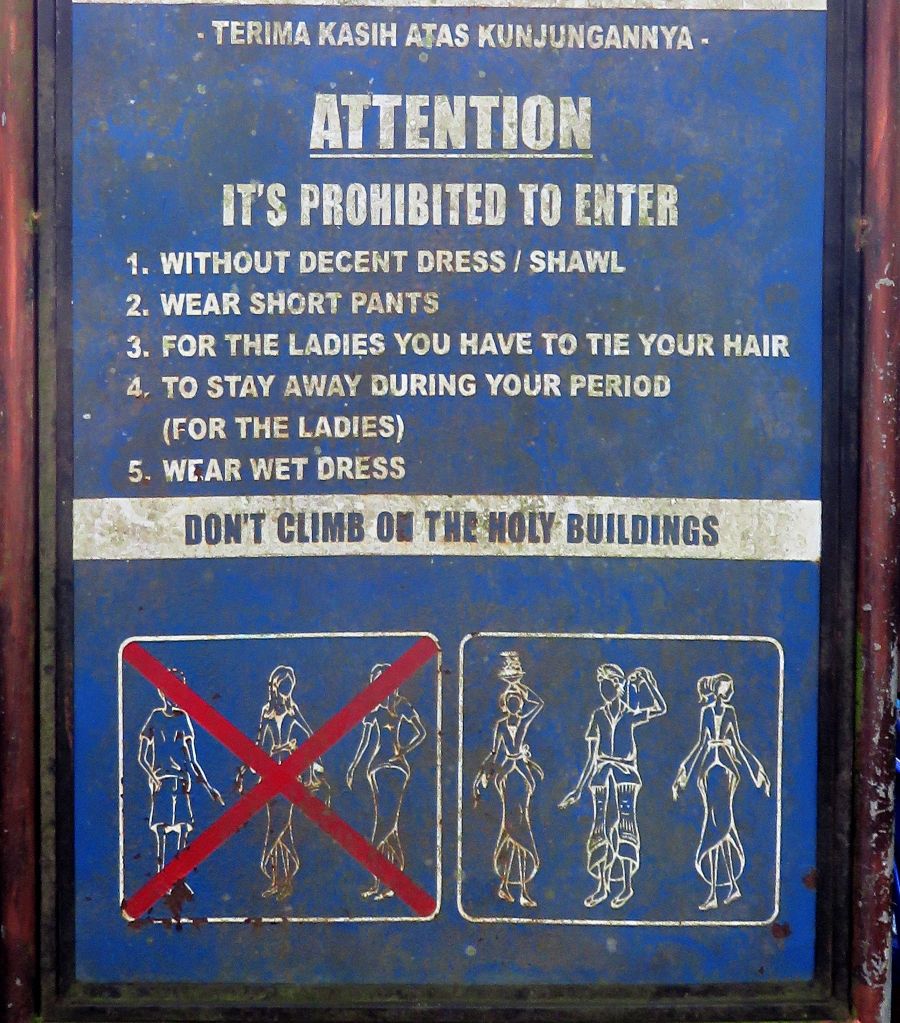

Visitors pass through the main gate and enter a vast courtyard abuzz with activity. The Idiots were visiting during the Lunar New Year, so there were thousands of Chinese people on holiday visiting Bali. Frequent group photos seem to be mandatory for Chinese tourists. Hindu worship involves lots of offerings… lots of busy activity supports the sacred functioning of the temple.
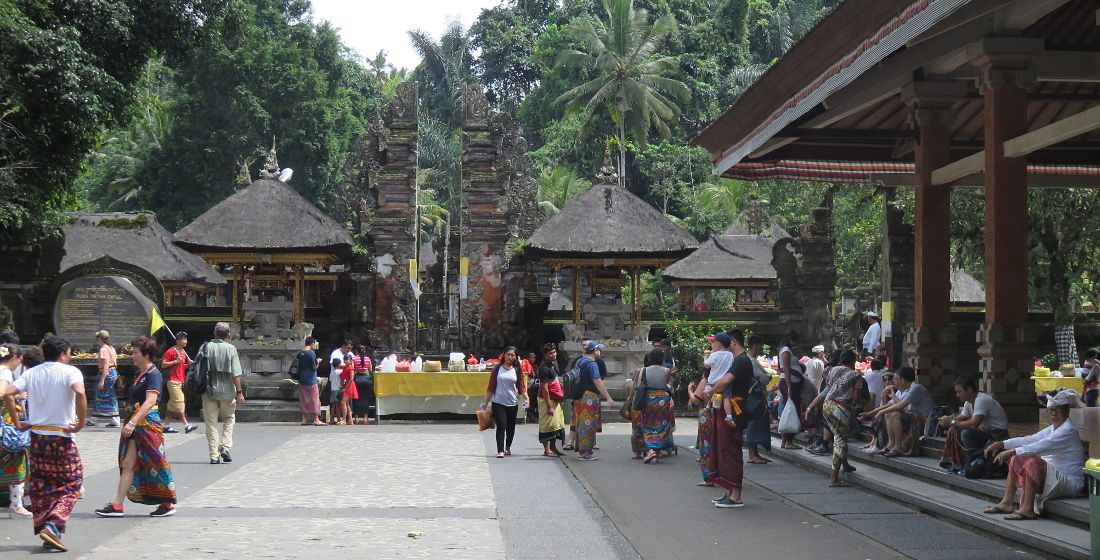
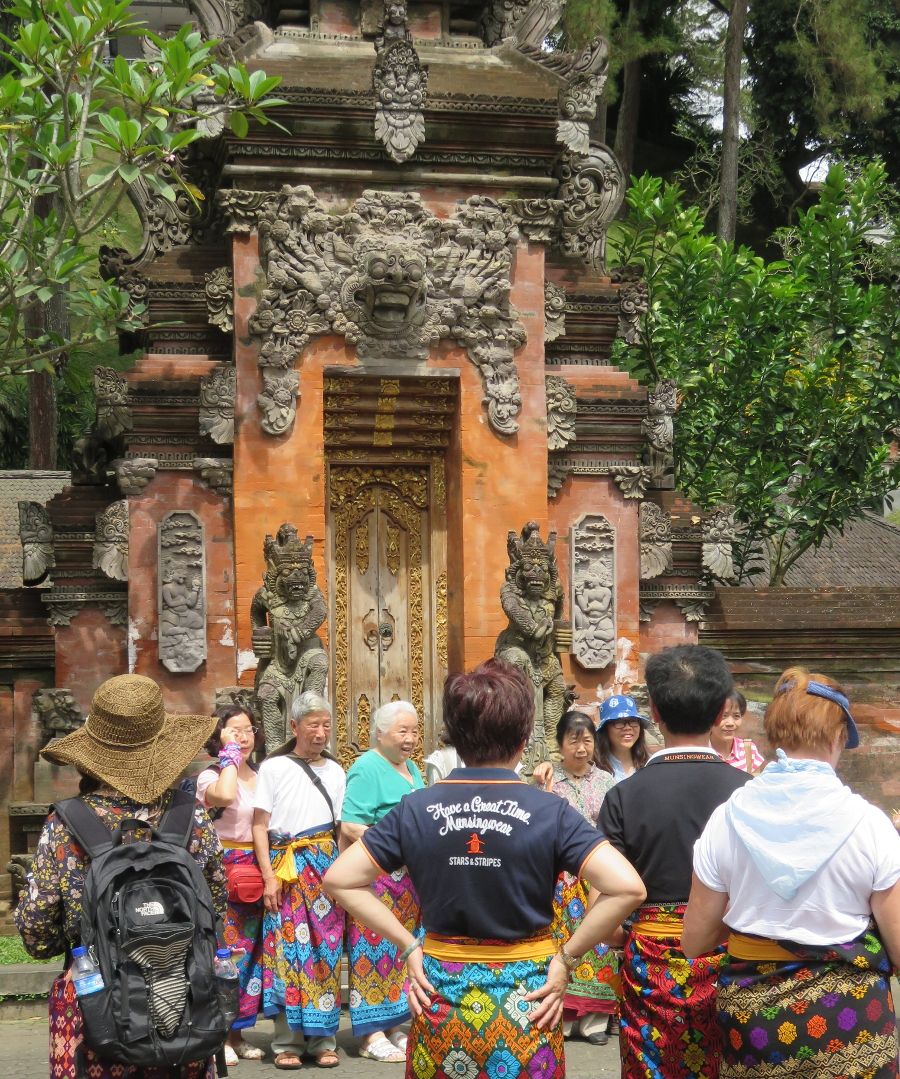


Throughout the millennia, all the major religions have had cleansing rituals. One finds ancient ritual baths in throughout Europe and Asia. Jews, Christians, and Muslims all have cleansing rituals. The ancient Greeks, Romans… even the Inca… built elaborate public baths. In India, Hindus practice great elaborate purification rituals in the Ganges and other rivers.
At Tirtha Empul, water from the sacred spring is channeled to a series of spouts that pour into two large purification pools. Each spout has its own name and traditions. People line up in the pool to approach the first of the carved spouts to cleanse their heads, faces, and bodies… and to drink some of the water… and then move on to the next line. As they work through the series of purifications, worshippers are washing away bad spirits… illness… bad luck…bad spirits… and bad karma… Above the spouts, incense scents the air and thousands of offerings ask the spirits for blessings.
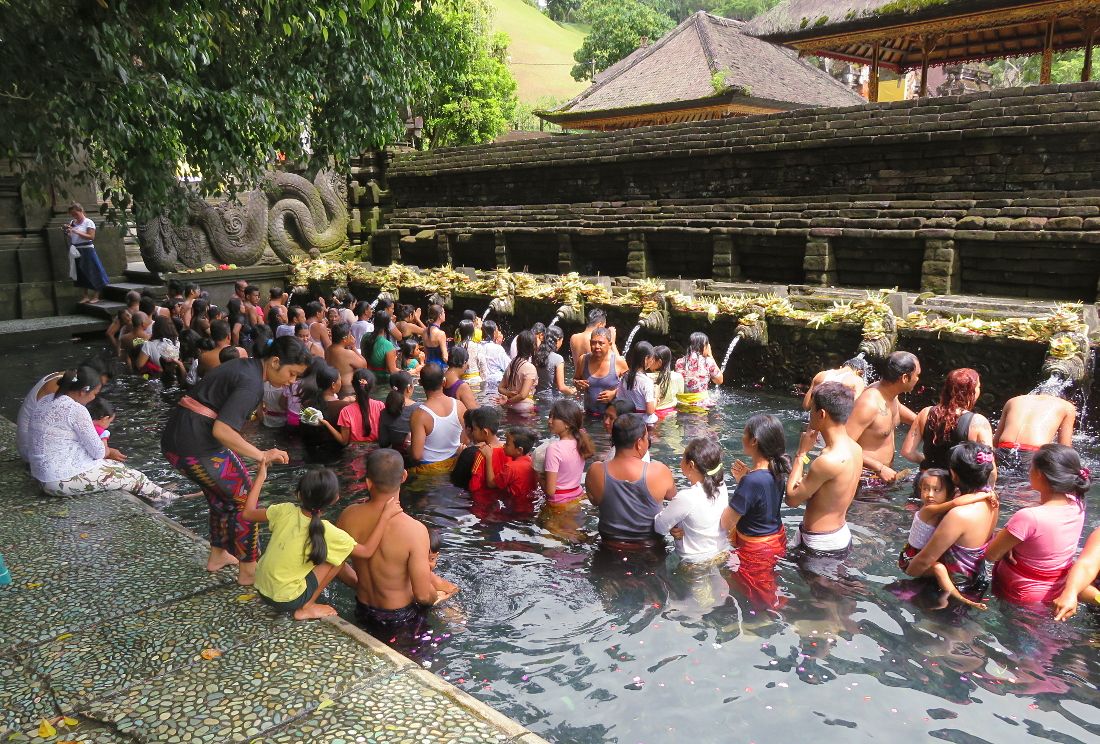
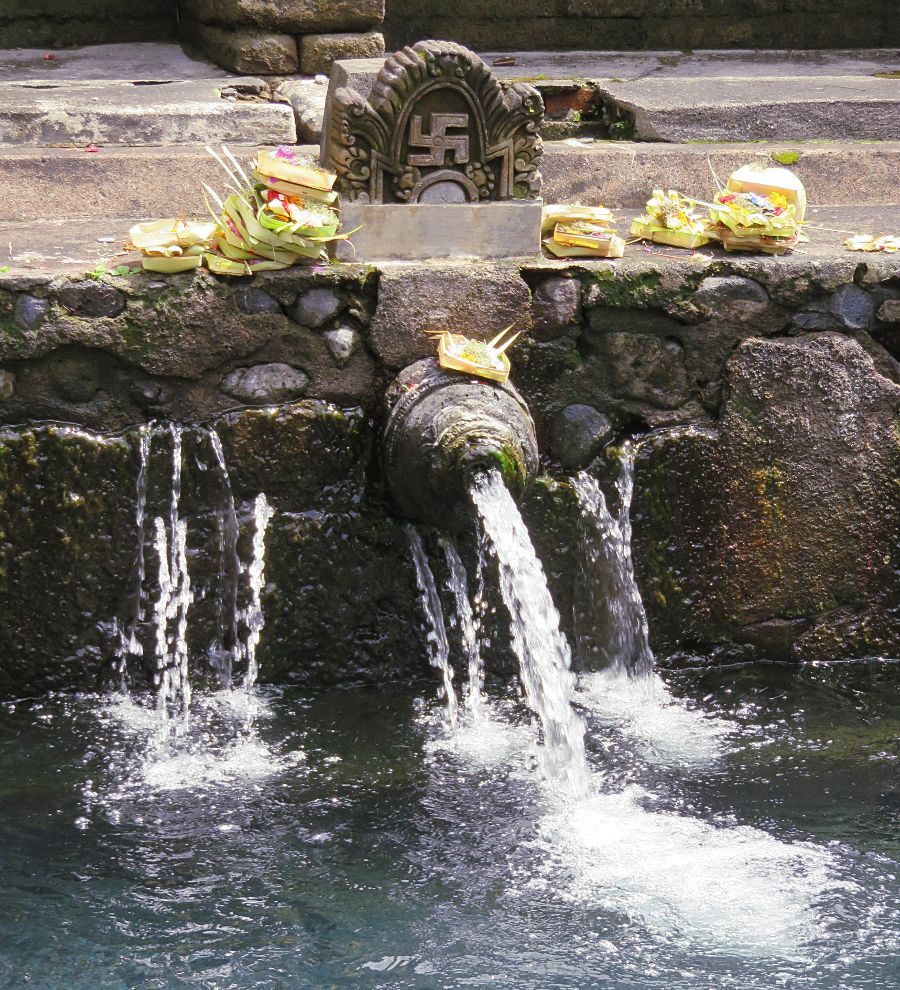
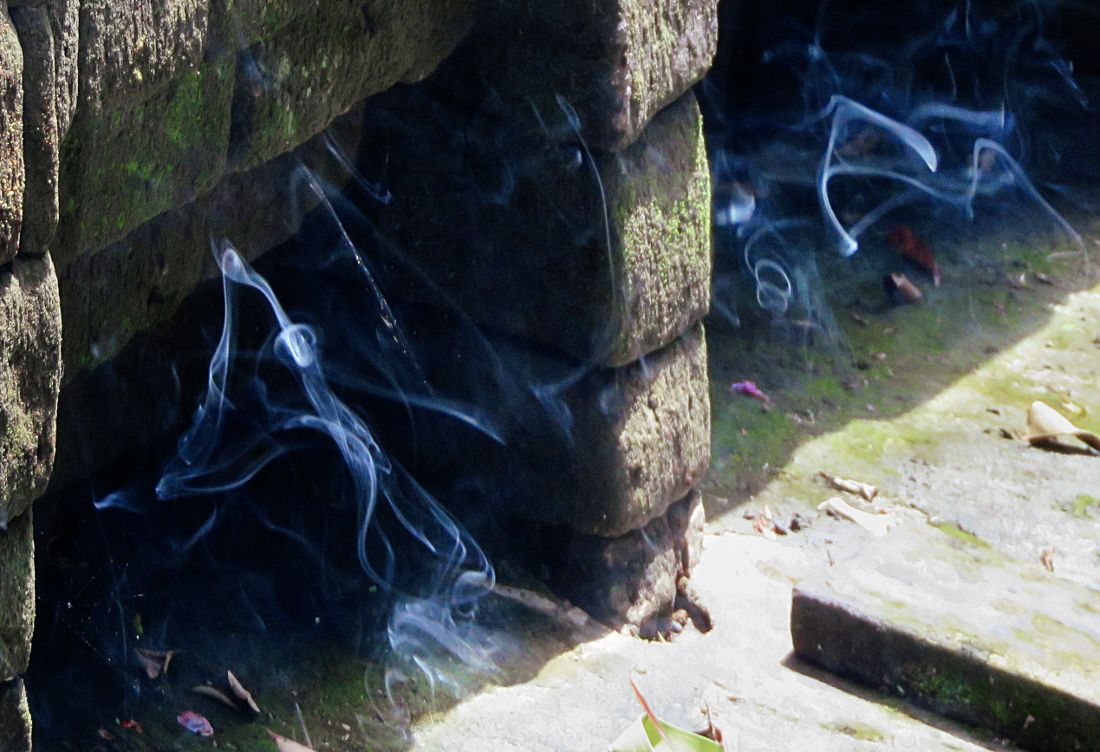
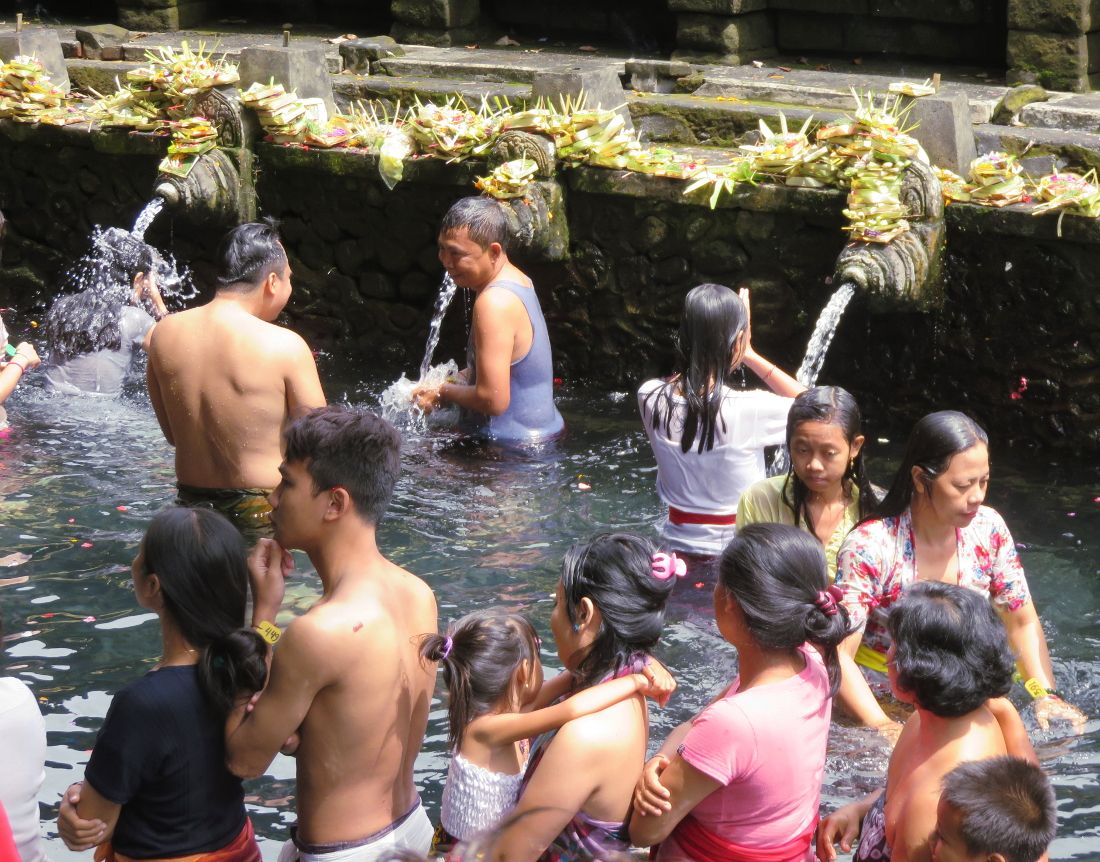
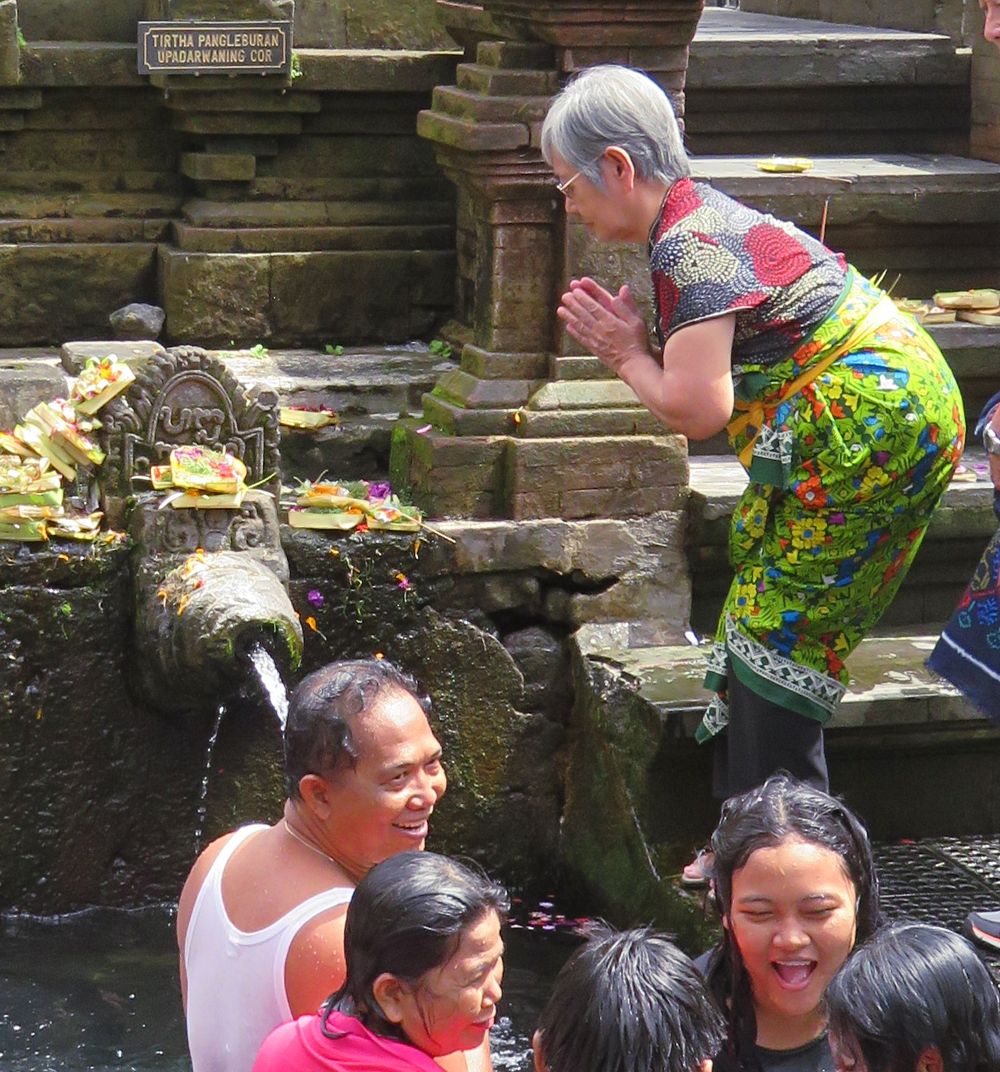

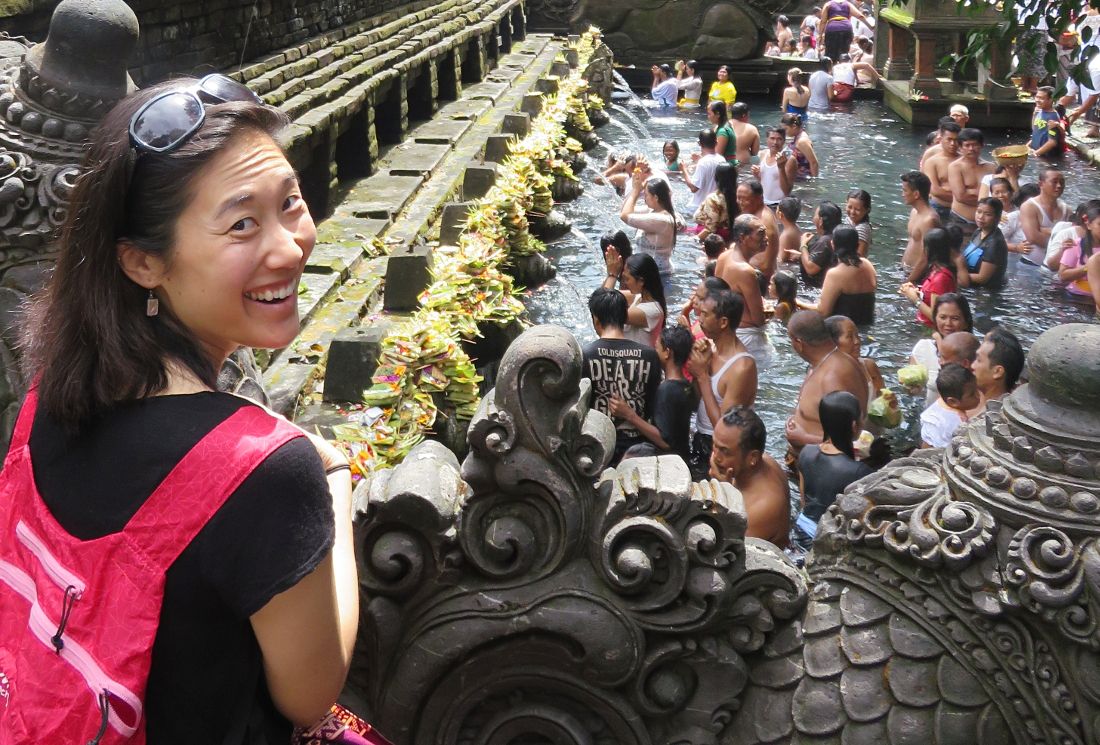
After purification, worshippers proceed to the inner temple. There are many “guardians” along the walk to the inner gates. The Idiots didn’t get the full story, but the three guardians with the children were a bit disturbing. There is a clearly pleasant mother figure… and what appears to be a stern but kind wise man… but that third is apparently a demon that will appear to help children but will actually eat them.
Behind the guardians is a steep hill with an immense palace built for Indonesia’s first President, Sukarno, in 1954. Today, with its great 360 degree vistas including views into the temple, it serves as a guesthouse for visiting dignitaries. The retaining wall behind the guardians is 20-25’ of beautifully-stacked rounded stones that, in the moist atmosphere around the spring, has developed an attractive mossy patina of age.

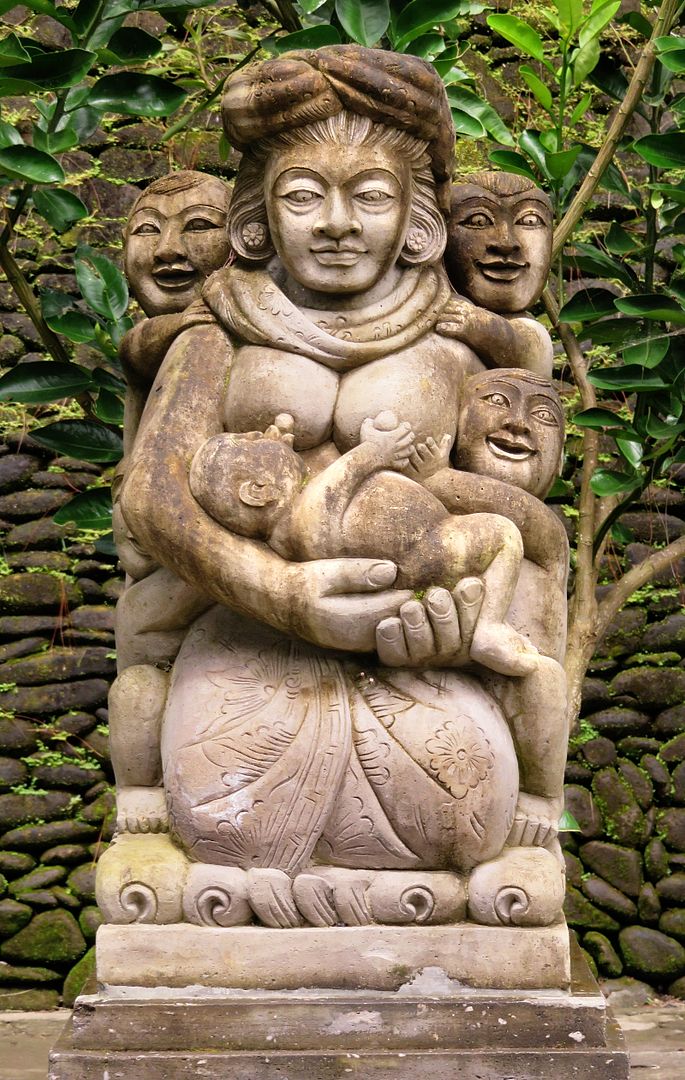


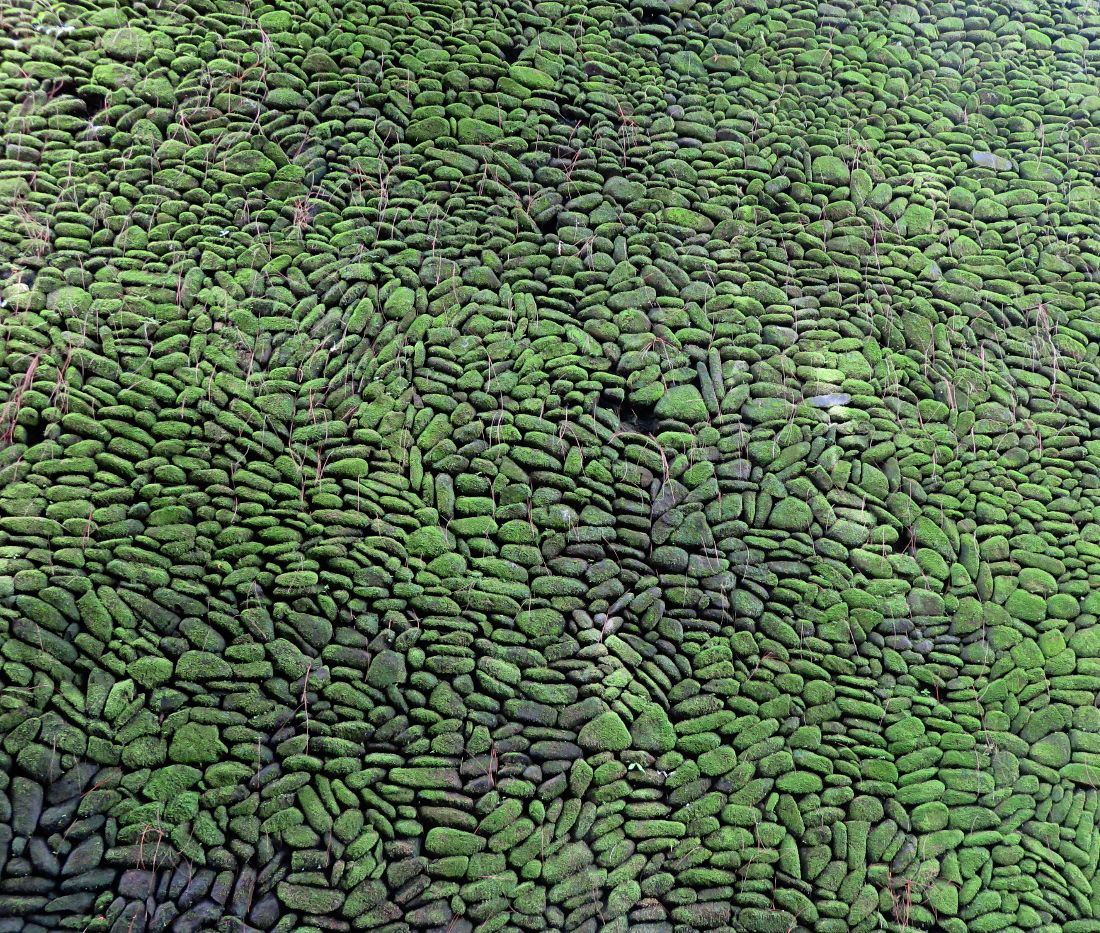
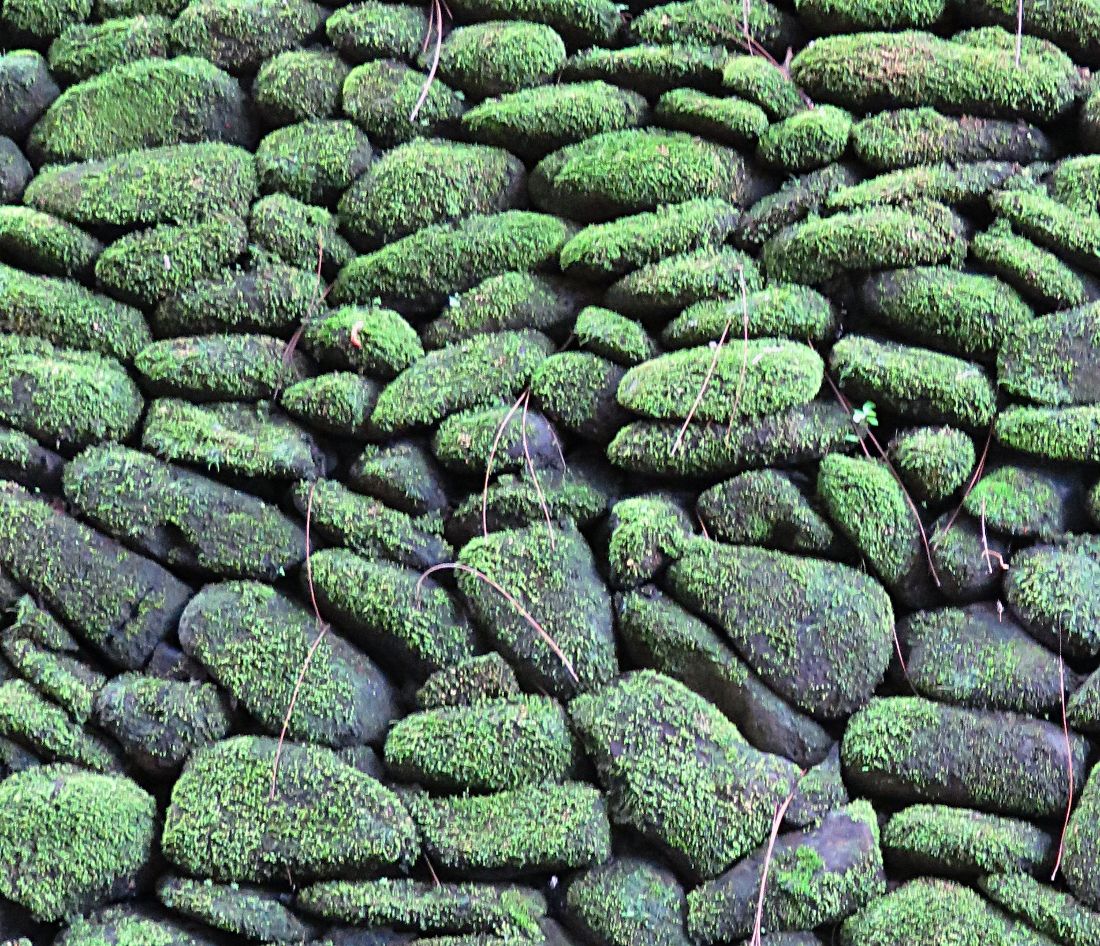
While Idiot Daughter tied up her hair to comply with temple rules, the Idiots watched a Japanese couple protesting as they were firmly turned away because their clothing was still damp. Some tourists just don’t grasp the concept of good manners for guests.
Inside the gate, visitors are greeted with a large pool housing the spring


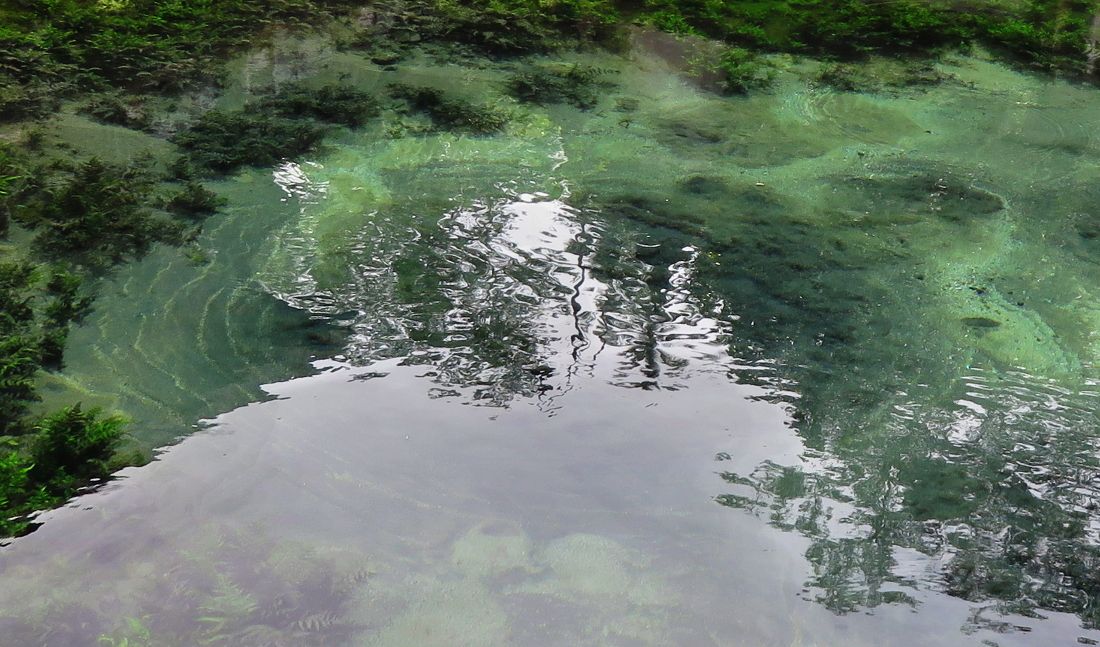
The overall temple is dedicated to Vishnu, but the large inner temple area complex has multiple shrines to all the primary Hindu gods. Worshippers cluster toward the front. Toward the back, it is actually possible to get away from the crowds and enjoy the gentle atmosphere of a place where people have practiced reverence continuously for over a thousand years.

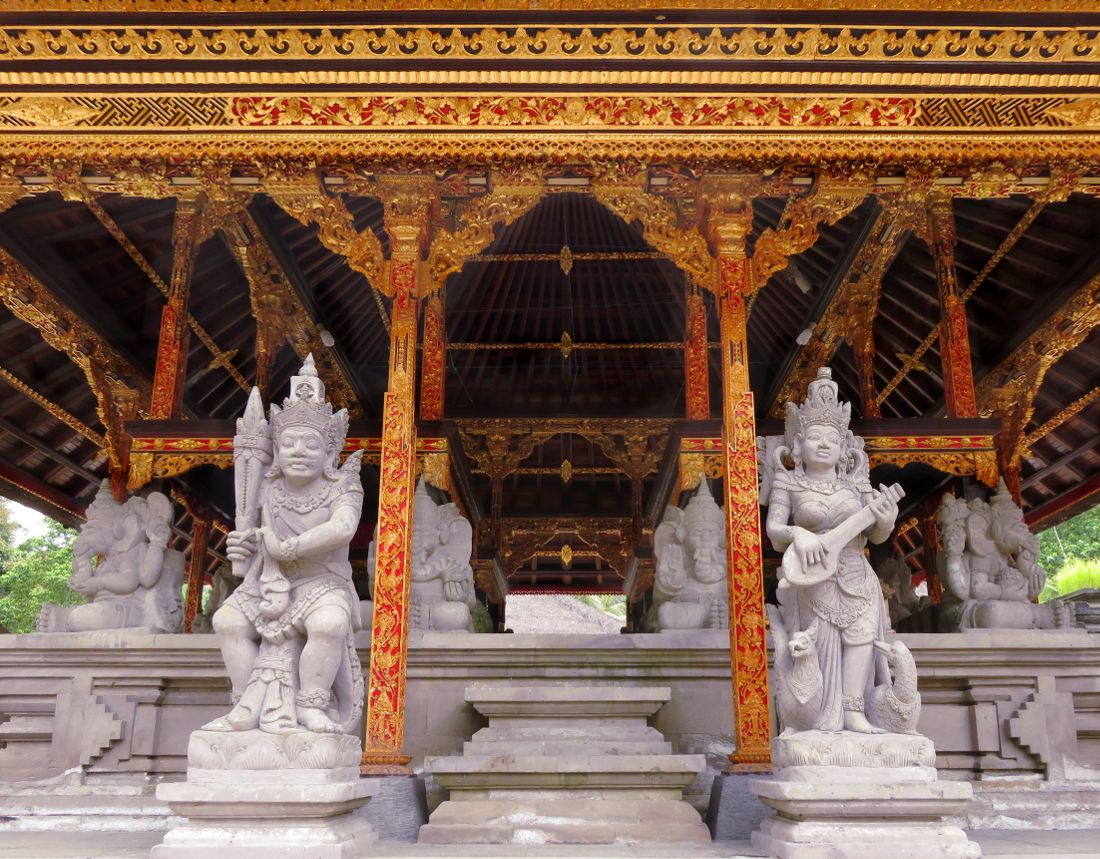
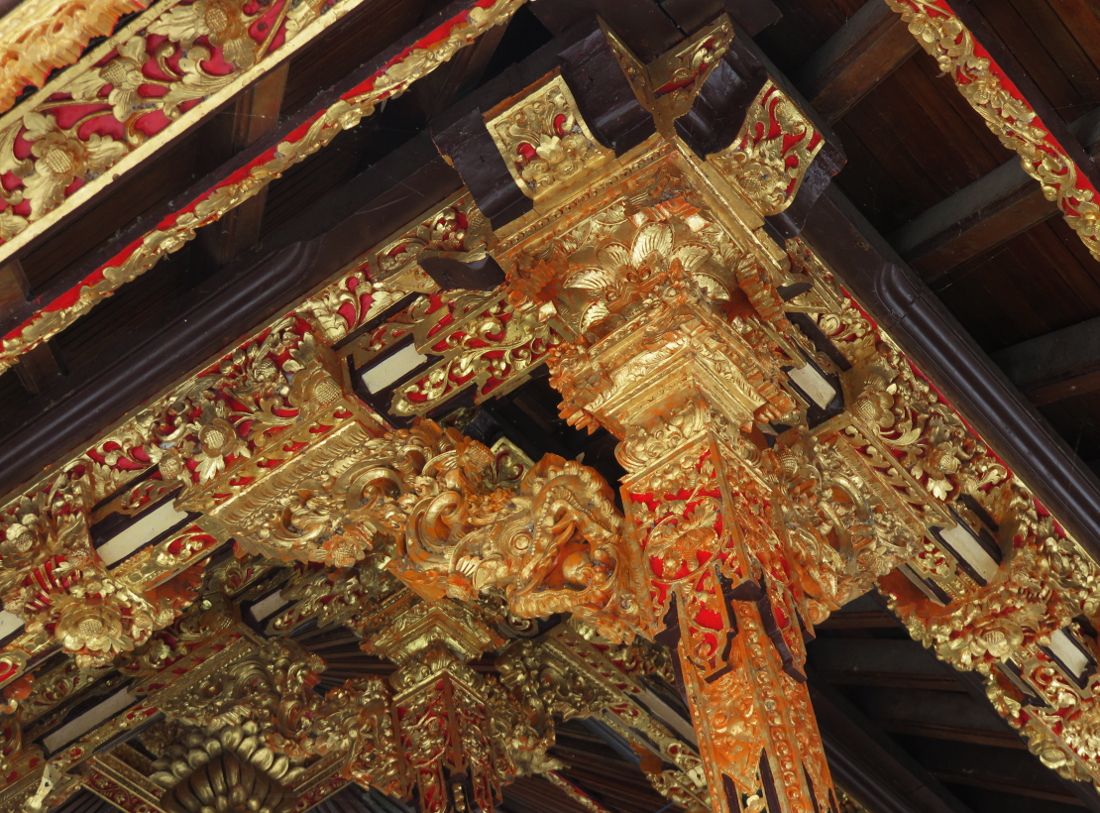

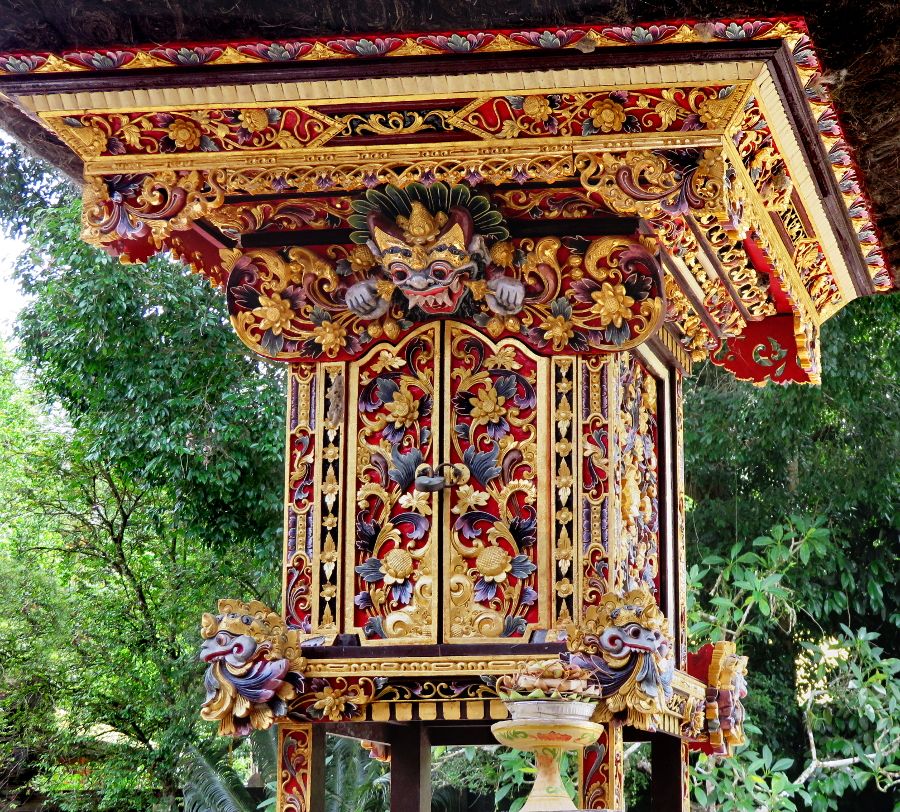

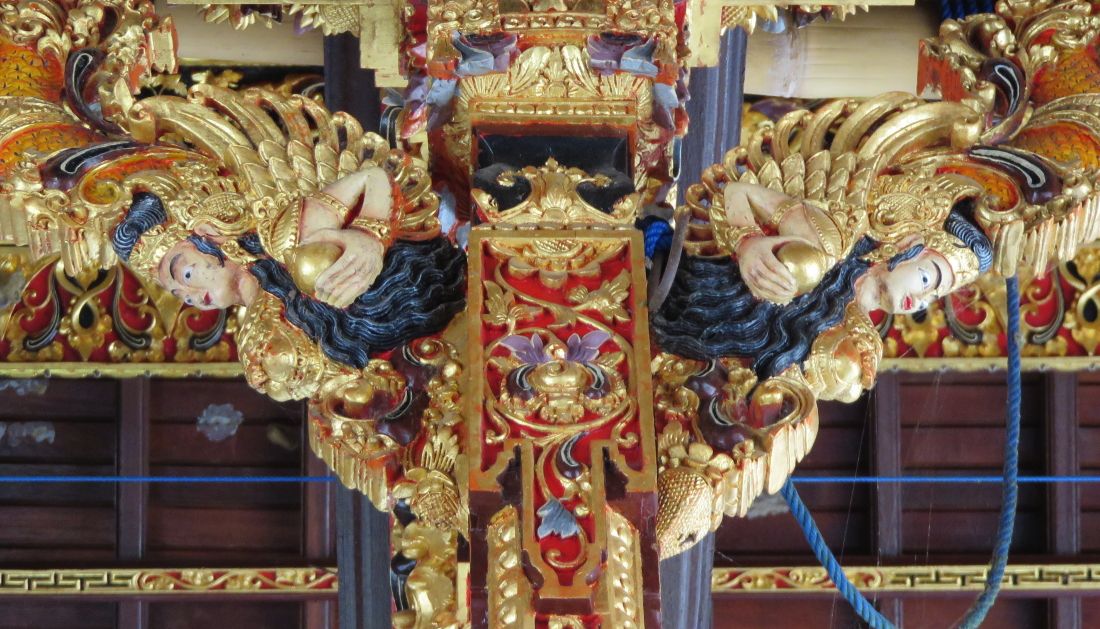

Sanny found some discarded offerings and explained to the Idiots how they are constructed. Palm leaves are woven into a canang – a small basket. Lime, betel nut, and gambier (a plant) are placed to represent the three great Hindu gods – Shiva, Vishnu, and Brahma. Other plant materials and food – even candy – may be included. The placement and colors of the flowers also have sacred meanings. A placement of money – often a ritual coin – completes the package known as a “canang sari.”
Canang sari are found everywhere on Bali. Sanny said every devout person will put out at least four a day. They are in shrines and temples… but also at the entrances to homes and businesses… in vehicles… on beaches… at the verge of rice fields – any place someone things they’d like good things from good spirits or where they think it might be a good idea to discourage bad spirits.
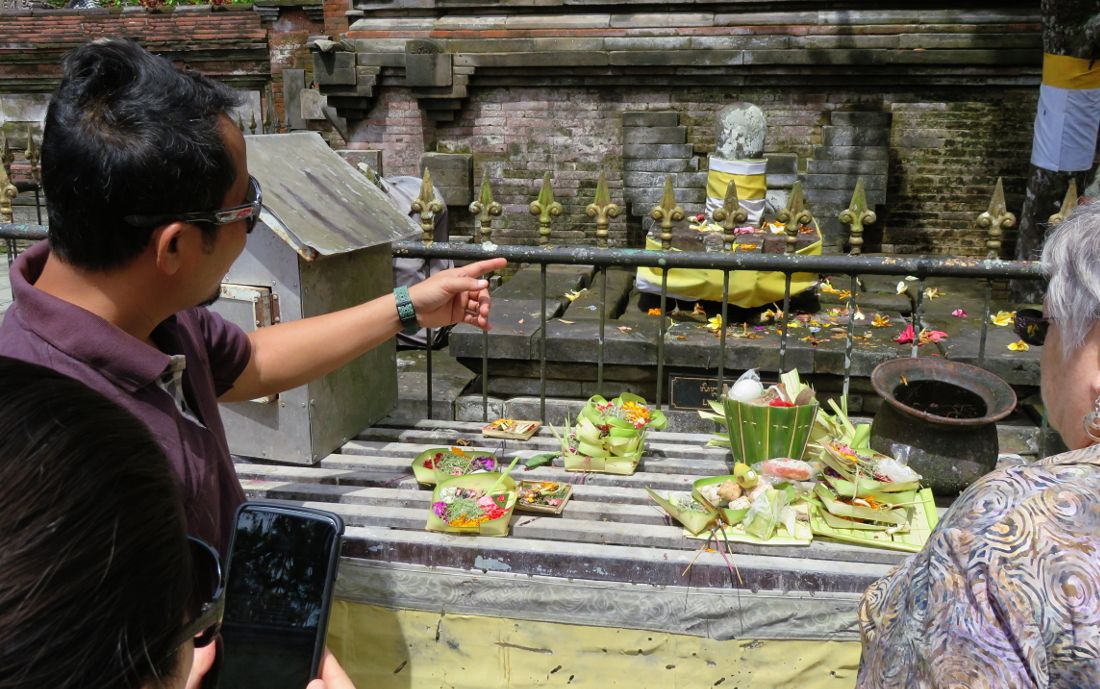
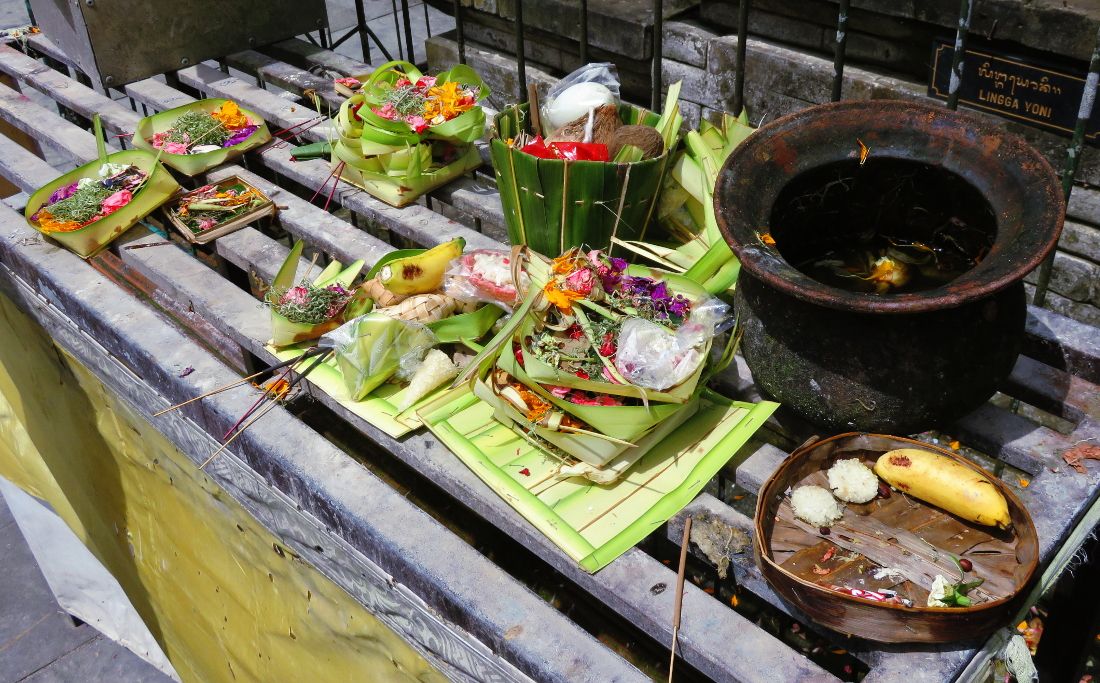
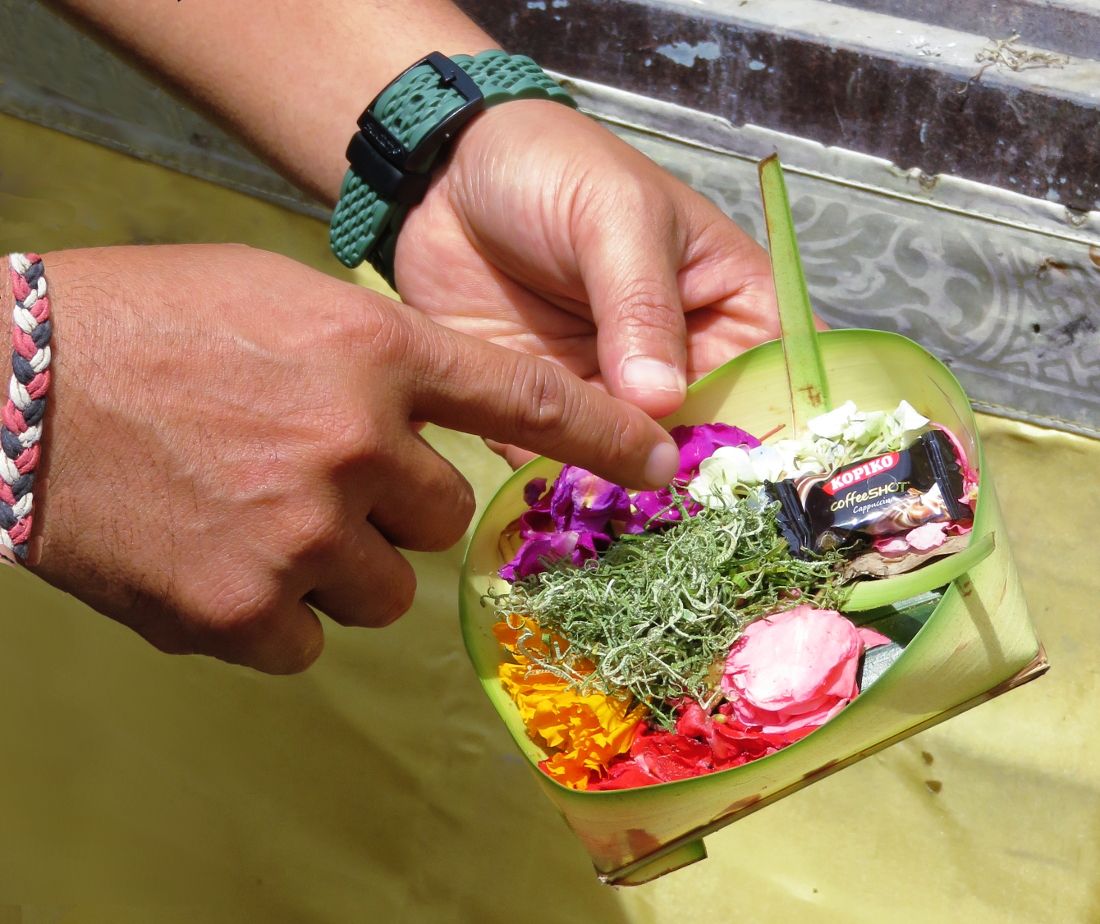
Priests perform numerous prayers and blessings and multiple-generation families approach with great devotion. Of course, it can get a bit long for some kids… but they are learning from their parents and grandparents and so far, in spite of all the “modern world” culture making its way into Balinese life, over 80% of the Balinese continue the traditions.

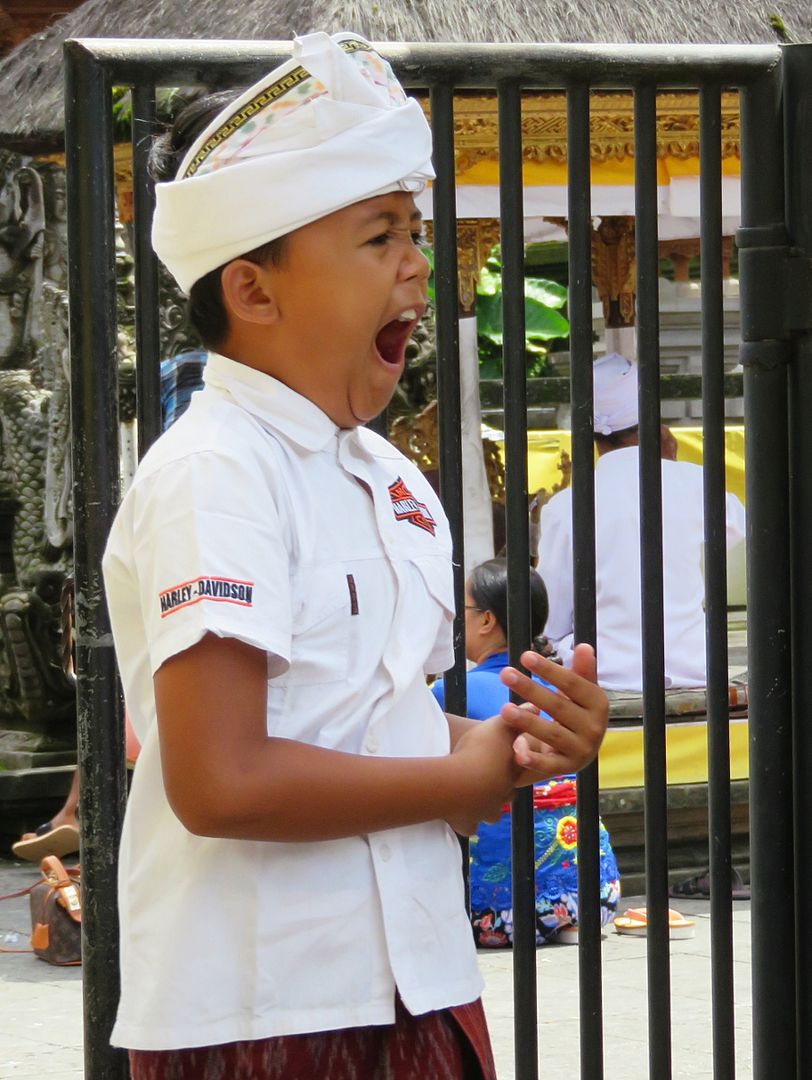
Sanny seemed a bit surprised when Idiot He turned back to spend more time at one of the shrines that is pretty much ignored by most visitors. Sanny was pleased at Idiot He’s interest and his comment that “this feels much older than most of the other shrines.”

This squat, pyramid-shaped shrine is the oldest structure at Pura Tirtha Empul. Sanny pointed out the carvings that are “simpler” than much of the ornamentation around them. That is because this shrine was constructed before metal tools came into Balinese life. The carvings were done stone-on-stone. The results are lovely…


Some of the sculptures tell tales. The Idiots have no idea if these are priests or soldiers… but there is a guy carrying bananas and other stuff with the same over-the-shoulder carrier used today… and the drummers out front look like they are having a heck of a time!

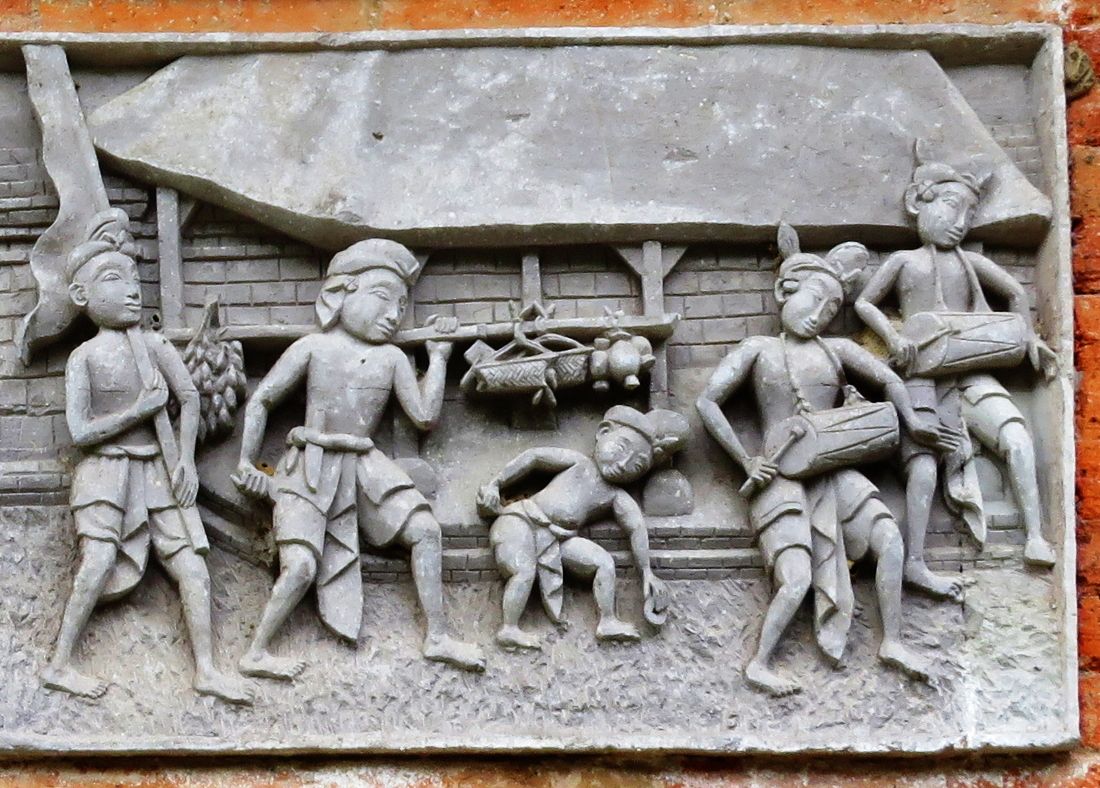
Looking closely, one can see that the child is picking up a “Chinese coin.” The Chinese had a pattern of marrying royal princesses to kings and important personages of other countries to expand their sphere of influence. The Balinese king married one of these princesses in the 12th century (there is a love triangle story including these two and a lake goddess… but that is a tale for another day!) and she asked him to include Chinese coins in every ceremony.
The distinctive coins, with a square hole and four Chinese symbols, are still used today. Since they are no longer used as currency, and those used for some ceremonies such as cremations are destroyed and cannot be recaptured, they are becoming rarer and the cost is becoming prohibitive for regular Balinese. Entrepeneurs to the rescue – people started making very inexpensive counterfeits. The Balinese government, concerned about what affect using fake coins might have on the religious and social life of the island, has come up with an alternative. They are recycling waste metal and minting “real” replacements for the Chinese coins.
Sanny continued to educate the Idiots as they made their way past intricate sculptures and towering gates.
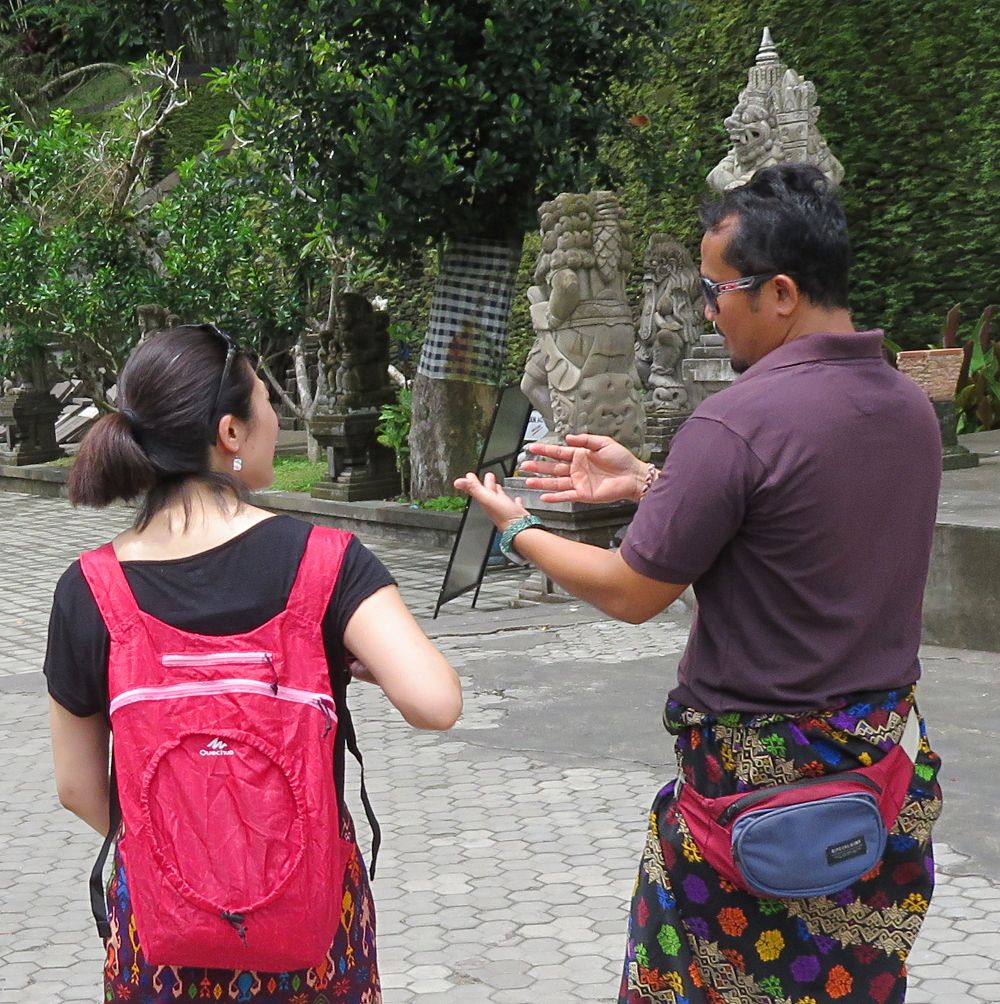

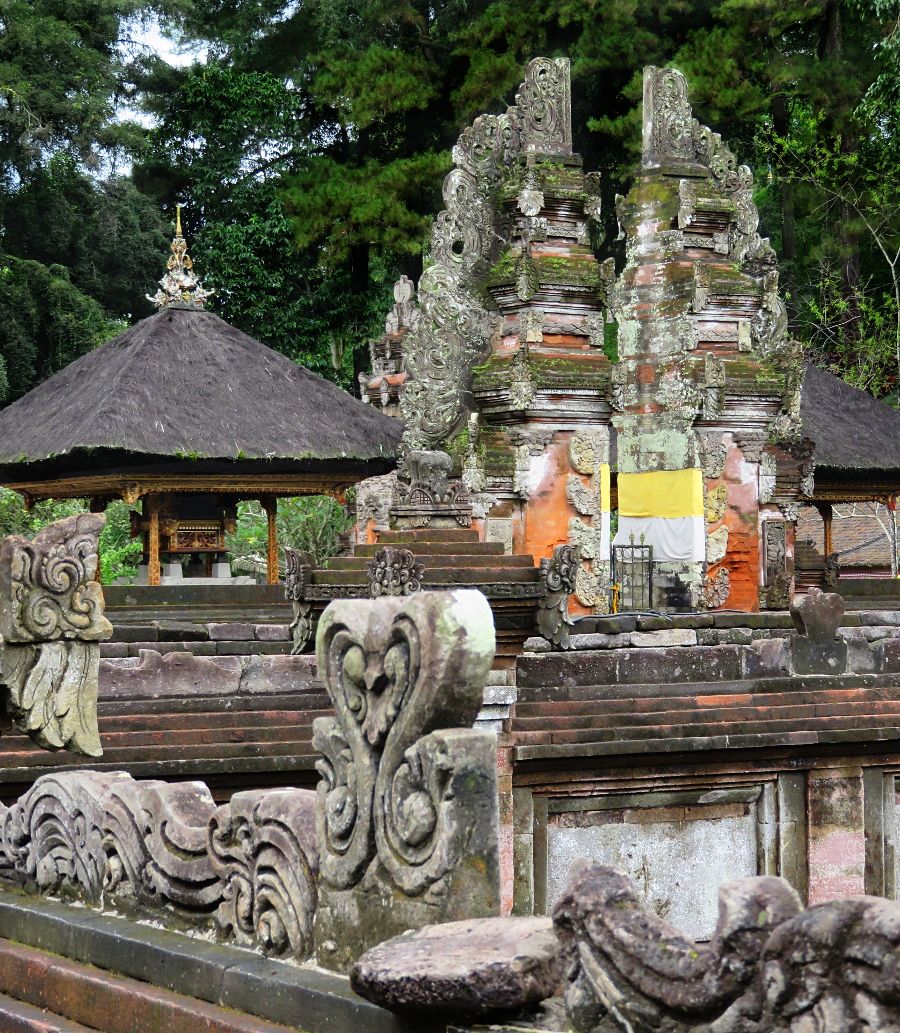
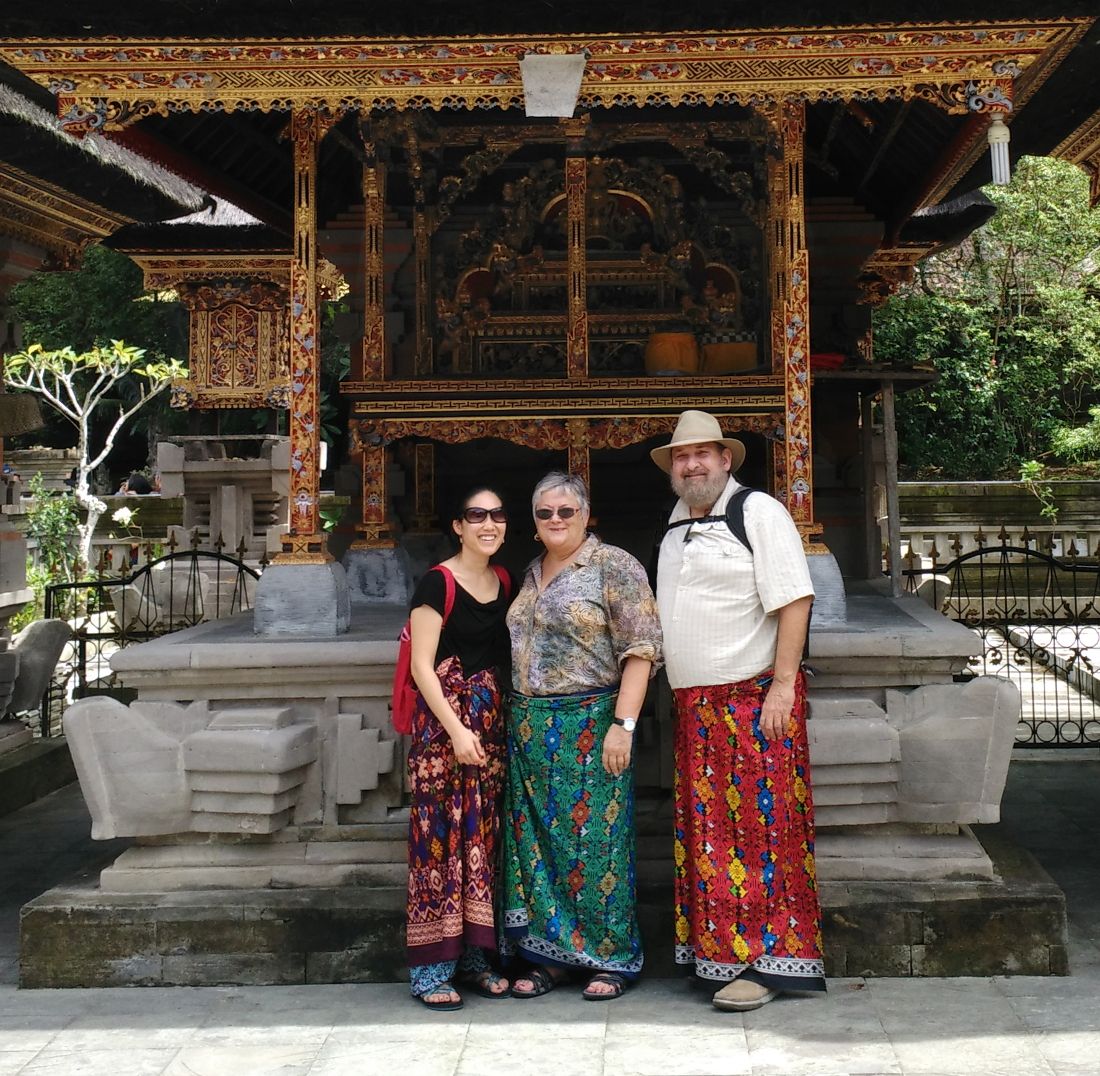
Departing the temple, the path passes a large koi pool… a great place to park bored kids while the adults continue to pray. A statue of a priest seems to send all visitors off with a blessing. Beyond, the waters of the sacred spring form eddies of flower petals s they come together to form the Pakerisan River.
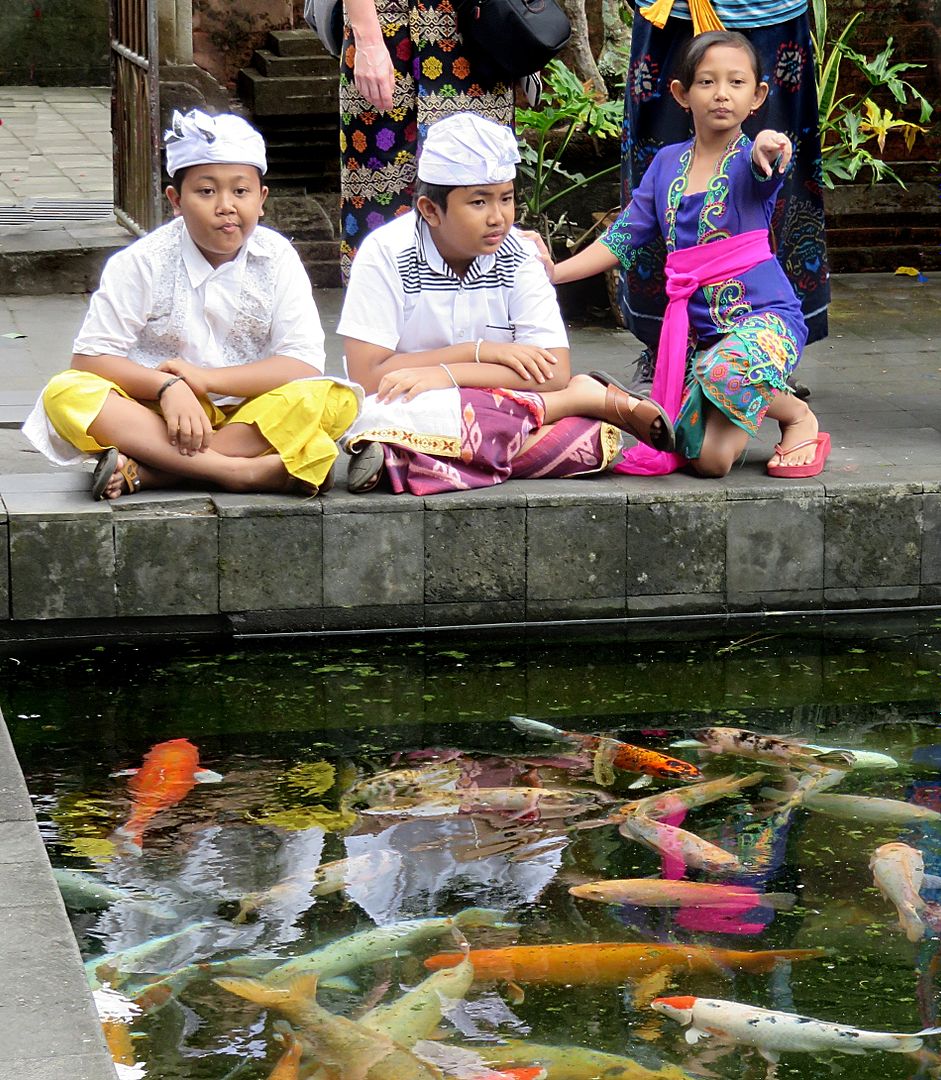
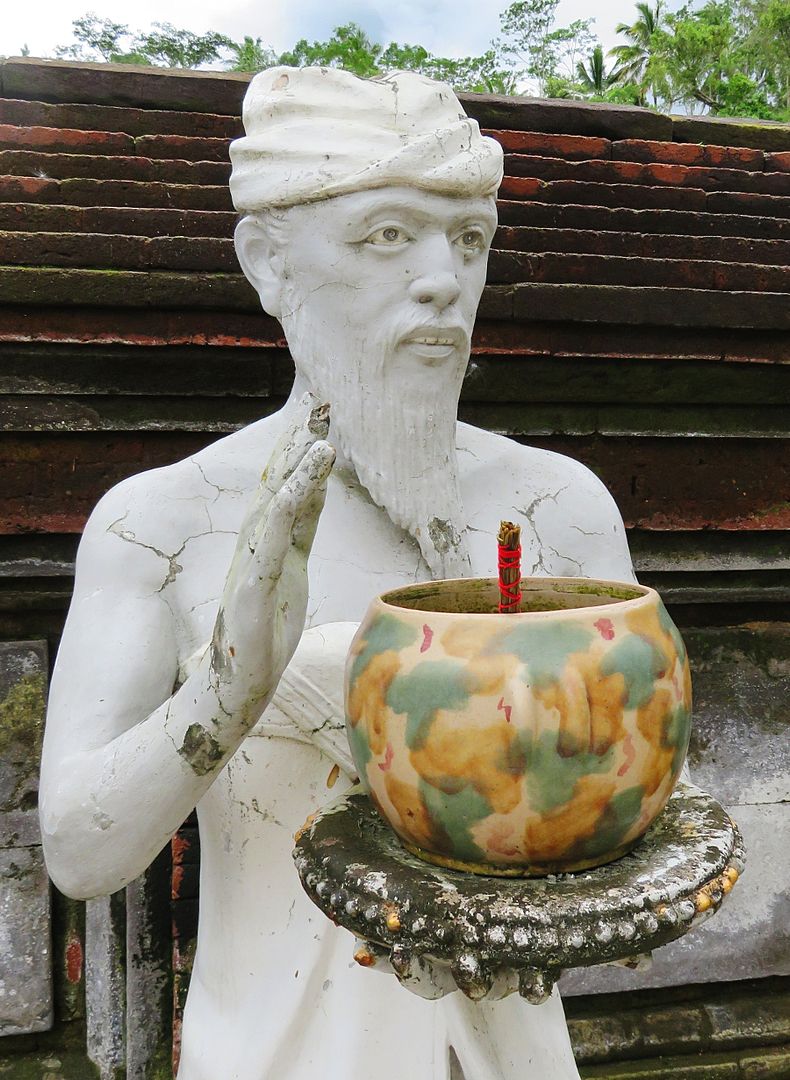
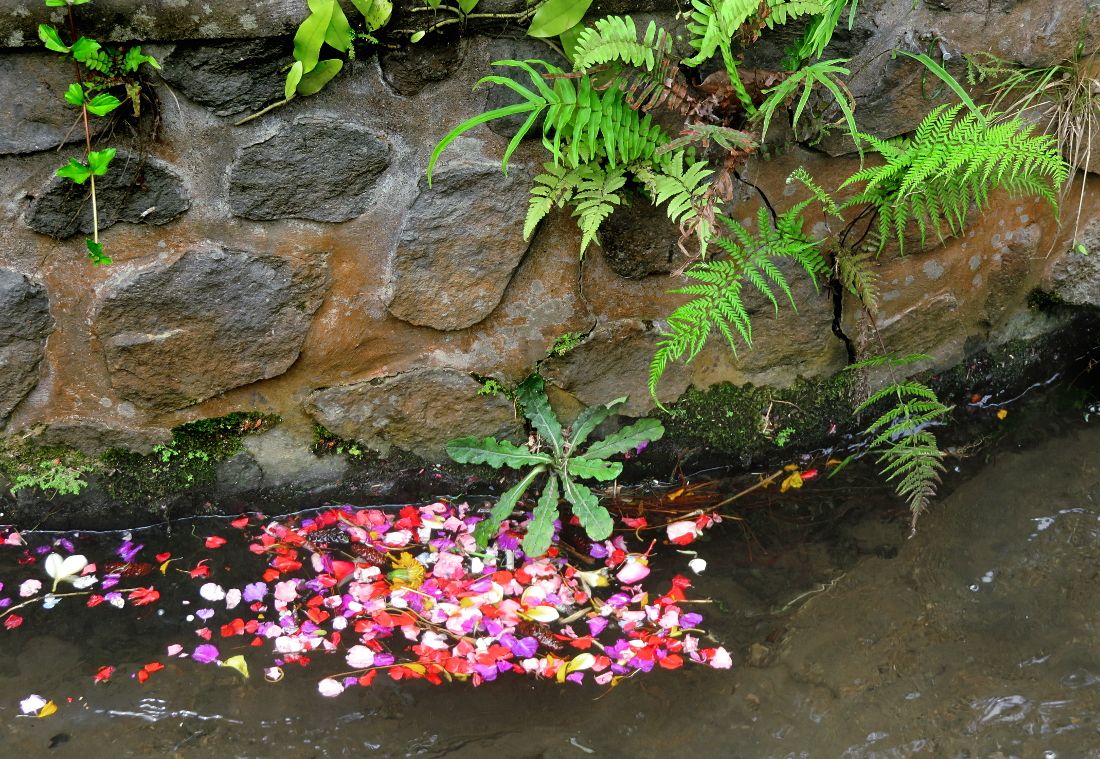
The rain held off until they left the temple, but then came on with a vengeance. The Idiots had lunch on the rim of the vast caldera of Mt. Batur. It isn’t unusual for volcanoes in Indonesia to build up, then blow their tops leaving a large caldera… and then for new cones to form in the caldera and pressures build up in later millennia. Mt. Batur has a rim about 16 miles in circumference, a newer cone, a large lake, and hot springs.
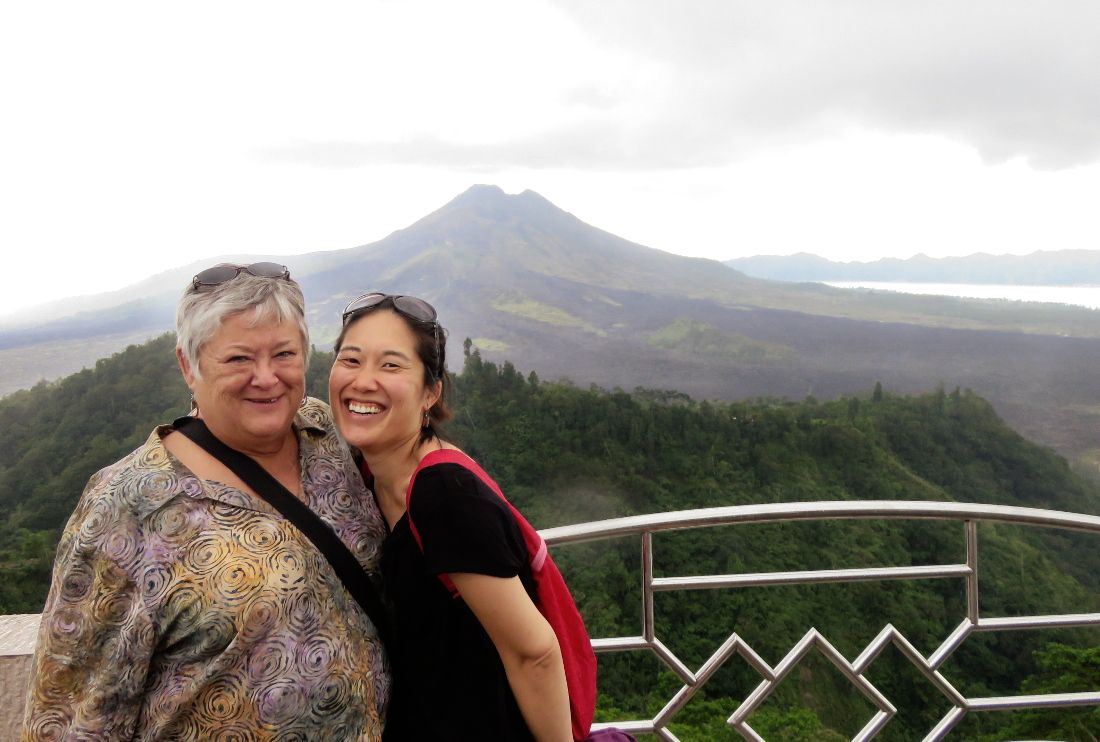
Final visit of the day… the historic sculptured rice fields at Tagalang. These are a UNESCO World Heritage Site. The local village farms them by the old methods. Planting and harvesting is done communally. If there is a bad harvest, they receive subsidies so they will maintain the terraces and the historic way of life.
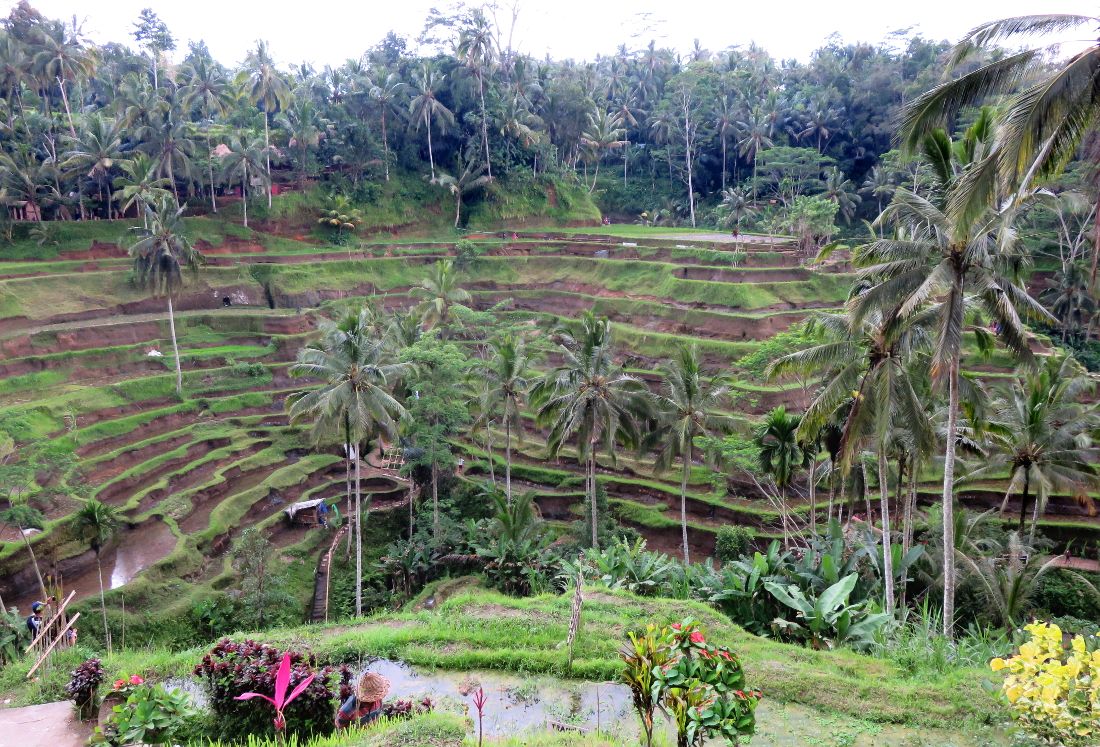
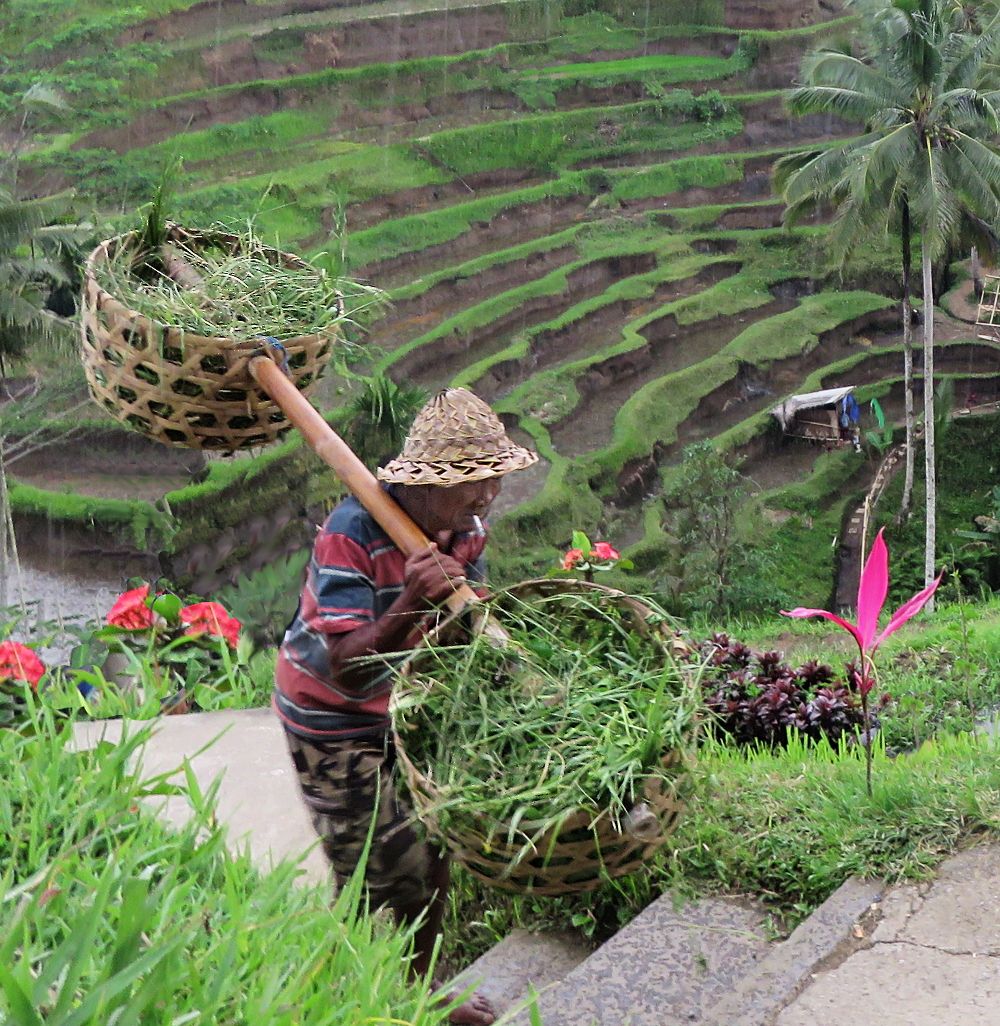
A portrait of Sanny in the rear view mirror. He maintained a steady conversation while negotiating wet narrow roads and the amazingly variety of vehicles hauling seemingly-impossible loads…
